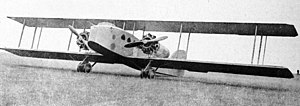Blériot 165
| Blériot 165/175 | |
|---|---|
 Blériot 165 |
|
| Type: | Airliner |
| Design country: | |
| Manufacturer: | |
| First flight: |
October 27, 1926 |
| Number of pieces: |
2 |
The Blériot 165 and the Blériot 175 (short- Bl-165 and BL-175 ) were twin-engine, as biplane designed commercial aircraft of the French manufacturer Blériot Aéronautique from the 1920s. Only one of the machines was ever built. The BI-175 was later converted into a BI-165. An unrealized military variant was the Blériot 123 .
History and construction
The Blériot 165 and its sister model should succeed the outdated Farman Goliath . The designers used the plans for the four-engine Blériot 115 . The first flight took place on October 27, 1926 .
The two pilots sat next to each other in an open cockpit. Up to 16 passengers could be accommodated in the cabin behind. The fuselage had a rectangular cross-section.
When driving the Bl-165 served by two Gnôme et Rhône licenses made Bristol Jupiter - radial engines , arranged between the wings of the biplane. The Bl-175, which was specially designed for night flights, was originally equipped with Renault 12 in -line engines and was also given the designation Bl-165 after being converted to Jupiter engines.
use
Both machines came into the possession of the airline Air Union . The machines, named Léonard de Vinci and Octave Chanute , served the route from Paris to London . In the competition with the Lioré-et-Olivier LeO 21, they proved to be inferior, so the airline decided not to procure any further copies.
The construction of another Bl-175, which the aviation pioneer Paul Codos wanted to use for a long-haul flight from Paris to Tokyo, did not materialize. Plans to develop the aircraft into a bomber called Blériot 123 also failed .
Technical specifications
| Parameter | Data |
|---|---|
| crew | 2 |
| Passengers | 16 |
| length | 14.75 m |
| span | 23 m |
| height | 4.85 m |
| Wing area | 119.1 m² |
| Empty mass | 2919 kg |
| Takeoff mass | 5600 kg |
| Top speed | 185 km / h |
| Service ceiling | 4000 m |
| Range | 525 km |
| Engines | two air-cooled nine-cylinder radial engines Gnôme et Rhône Jupiter 9A each with 213 kW (290 PS) |
